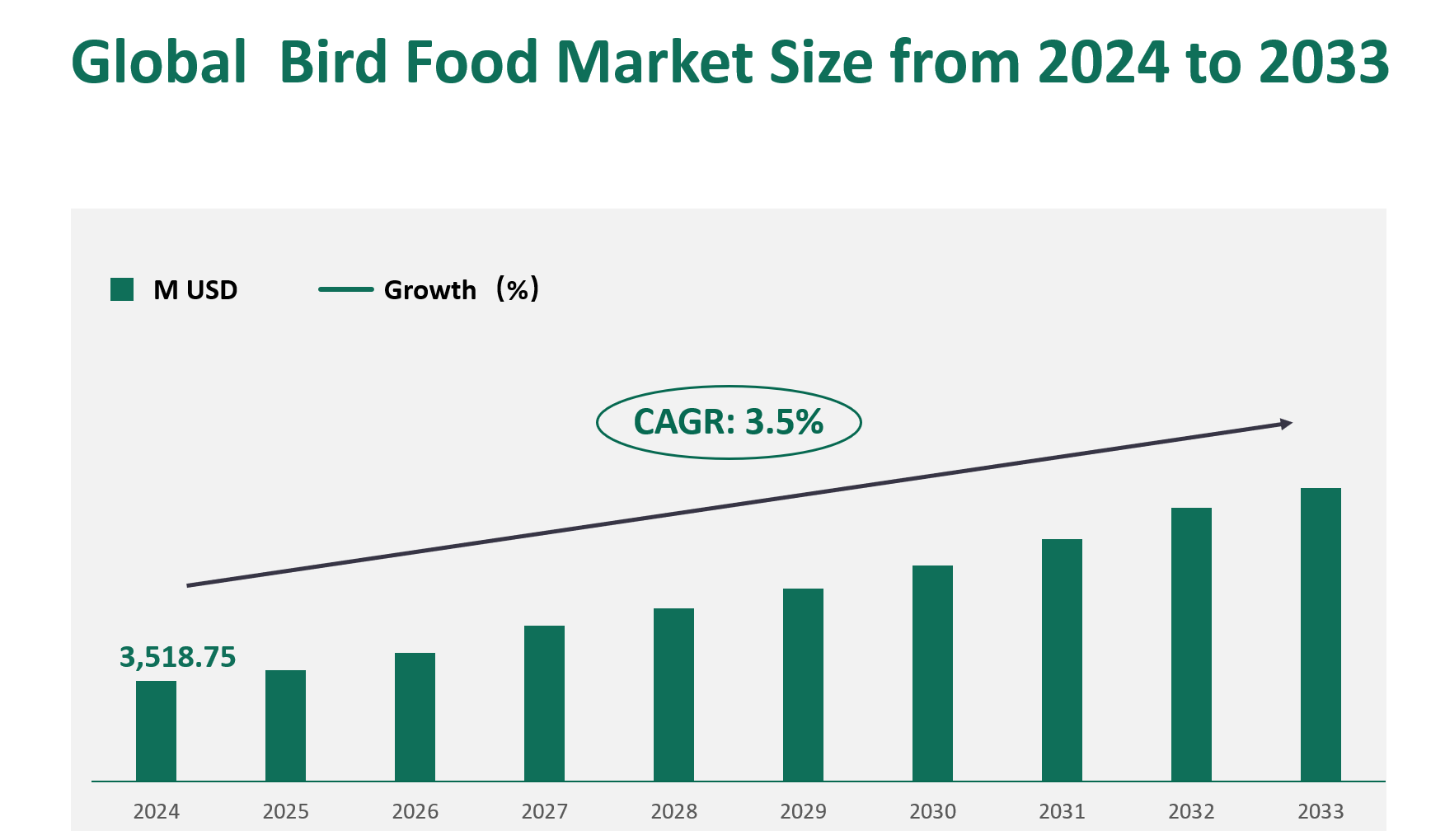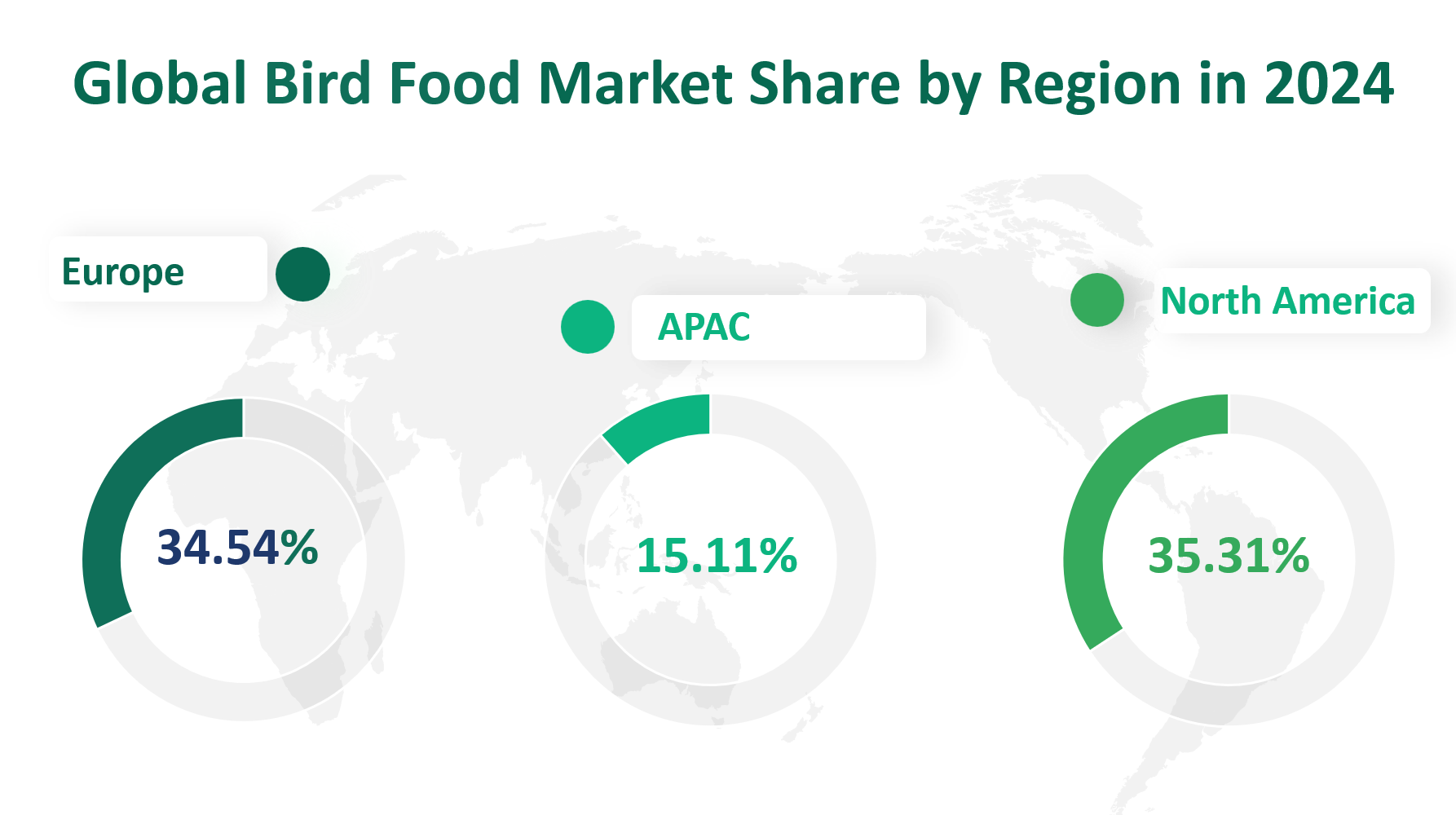1. Global Bird Food Market Insight Analysis
The global bird food market is projected to reach a value of 3,518.75 million USD in 2024, with a Compound Annual Growth Rate (CAGR) of 3.5% from 2024 to 2033.
Bird food refers to specialized diets formulated to meet the nutritional needs of various bird species, both wild and domesticated. These foods are distinct from human foods and are designed to provide essential nutrients, vitamins, and minerals required for the health and well-being of birds. Common ingredients include black sunflower seeds, mealworms, suet, and various seed mixtures.
Figure Global Bird Food Market Size (M USD) and CAGR (2024-2033)

2. Driving and Limiting Factors of Bird Food Market Growth
The growth of the global bird food market is influenced by several key drivers and constraints. On the positive side, the increasing popularity of bird feeding activities is a significant factor. This trend is particularly evident in regions like North America and Europe, where bird feeding has been a cultural tradition for decades. The United States alone has over 57 million families engaging in bird feeding activities annually. This cultural affinity for bird feeding is supported by growing environmental awareness and the desire to support local wildlife. Additionally, the rise in pet bird ownership in countries like Japan, Brazil, and India has further fueled the demand for high-quality bird food.
Another driving factor is the increasing consumer preference for nutritionally balanced and premium bird food products. Consumers are becoming more aware of the dietary needs of birds and are willing to invest in higher-quality products that offer better health benefits. This trend is supported by advancements in bird food formulations and the availability of specialized products designed for specific bird species or seasonal needs.
However, the market also faces several limiting factors. One of the primary concerns is the potential for disease transmission among birds that gather at feeding stations. Outbreaks of avian diseases can lead to temporary bans on bird feeding activities, as seen in some regions during the COVID-19 pandemic. Additionally, the risk of predation and bird collisions with windows near feeders poses a challenge to the industry. These risks can deter some consumers from participating in bird feeding activities, thereby limiting market growth.
3. Technological Innovation in the Bird Food Market
Technological advancements have played a crucial role in the development of the bird food market. Innovations in feeder technology, such as the introduction of smart bird feeders, have enhanced the bird feeding experience for consumers. These smart feeders can capture images and identify bird species, providing valuable insights and enhancing the overall bird watching experience. The COVID-19 pandemic has also accelerated the adoption of online shopping for bird food, with many consumers preferring the convenience and safety of purchasing products online.
Corporate mergers and acquisitions have also shaped the bird food market. Major players in the industry, such as CGPC, Wild Birds Unlimited, and Vitakraft, have expanded their market presence through strategic acquisitions and partnerships. These moves have allowed companies to diversify their product offerings, enhance their distribution networks, and strengthen their competitive positions. For example, CGPC’s acquisition of smaller bird food manufacturers has enabled the company to expand its product range and tap into new market segments.
4. Global Bird Food Market Size by Type
The bird food market is categorized into three primary product types: General Food, Special Food, and Others.
General Food refers to the standard types of bird food that are suitable for a wide range of bird species. These include common seeds such as black sunflower seeds, millet, and mixed seeds. These products are designed to meet the basic nutritional needs of most birds and are typically sold in bulk. The market value of General Food is projected to reach 2,725.05 million USD in 2024.
Special Food is formulated to meet the specific nutritional requirements of certain bird species. These products often include specialized blends, such as high-protein mixes for breeding birds, or specialized diets for exotic birds. Special Food is designed to support the health and well-being of birds with unique dietary needs. The market value of Special Food is forecasted to be 453.82 million USD in 2024.
Table Global Bird Food Market Size by Type in 2024
Market Size (M USD) 2024 | Market Share | |
| 2725.05 | 77.44% |
| 453.82 | 12.90% |
Others | 339.88 | 9.66% |
5. Global Bird Food Market Size by Application
Tube feeders are cylindrical bird feeders designed to hold seeds and other small bird food items. They are equipped with perches and feeding ports, allowing birds to feed comfortably. Tube feeders are popular for their ability to keep food clean and dry, reducing waste and attracting a variety of bird species. The market value for bird food used in tube feeders is forecasted to be $1,377.50 million in 2024.
Feeder houses, also known as hopper feeders, are designed to hold larger quantities of bird food. They typically have a gravity-fed mechanism that dispenses food into a tray at the bottom. Feeder houses are ideal for attracting a wide range of bird species and are known for their durability and ease of use. The market value for bird food used in feeder houses is projected to be $353.84 million in 2024.
Bird tables are flat, open platforms designed for placing bird food. They can accommodate a variety of food types, including seeds, fruits, and insects. Bird tables are popular for their simplicity and versatility, making them suitable for both casual and serious bird feeders. The market value for bird food used on bird tables is expected to reach $874.79 million in 2024.
Ground feeding involves placing bird food directly on the ground or using specialized ground feeders. This method is particularly popular for attracting ground-dwelling birds such as doves and sparrows. Ground feeding is simple and effective, requiring minimal equipment. The market value for bird food used in ground feeding is forecasted to be $912.61 million in 2024.
Table Global Bird Food Market Size by Application in 2024
Application | Market Size (M USD) 2024 | Market Share |
Tube Feeders | 1377.50 | 39.15% |
Feeder Houses | 353.84 | 10.06% |
Bird Tables | 874.79 | 24.86% |
Ground Feeding | 912.61 | 25.94% |
6. Global Bird Food Market Size by Region
North America remains the largest regional market by revenue, with an estimated value of 1,242.57 million USD in 2024. This region’s dominance is attributed to the long-standing cultural tradition of bird feeding, particularly in the United States and Canada. The presence of a large number of bird species and the high participation rate of households in bird feeding activities further contribute to the market’s strength.
Europe follows closely with a market value of 1,215.31 million USD in 2024. The region’s bird feeding culture is deeply rooted, especially in countries like the United Kingdom, Germany, and France. European consumers are known for their preference for high-quality, organic bird food products. The market is also supported by government initiatives promoting wildlife conservation and sustainable feeding practices.
Asia Pacific is the fastest-growing region, with a projected market value of 531.79 million USD in 2024. This growth is driven by increasing urbanization and the rise in pet bird ownership in countries like China, Japan, and South Korea. The region’s market is characterized by a growing middle class with disposable income, leading to higher spending on pet care and bird feeding activities.
South America is expected to reach a market value of 498.42 million USD in 2024. Brazil stands out as a key market in this region, with birds being a popular pet category.
Middle East and Africa is a smaller but emerging market, with an estimated value of 30.66 million USD in 2024. The region’s market is driven by increasing urbanization and the growing interest in bird feeding as a hobby.
Figure Global Bird Food Market Size by Region in 2024

7. Global Bird Food Market Analysis by Major Players
7.1 CGPC (Central Garden & Pet Company)
Introduction and Business Overview: CGPC is a leading provider of pet and garden products, with a strong focus on bird food. Established in 1866, the company has a global presence and is headquartered in the United States. CGPC is committed to providing high-quality products that enhance the lives of pets and wildlife.
Products Offered: CGPC offers a wide range of bird food products, including general bird food, special bird food, and specialized diets for specific bird species. Their products are formulated to provide balanced nutrition and support the health of birds.
7.2 Wild Birds Unlimited
Introduction and Business Overview: Wild Birds Unlimited is a retail store specializing in bird seeds, bird feeders, and other bird feeding supplies. Established in 1981, the company has a strong presence in North America and is known for its commitment to supporting wild bird conservation.
Products Offered: Wild Birds Unlimited offers a variety of bird food products, including seed blends, suet products, and specialty mixes. Their products are designed to attract a wide range of bird species and provide essential nutrition.
7.3 Global Harvest Foods
Introduction and Business Overview: Global Harvest Foods is a family-owned company that has been producing high-quality bird food since 1982. The company is headquartered in the United States and is known for its commitment to safety and quality.
Products Offered: Global Harvest Foods offers a comprehensive range of bird food products, including blended seeds, straight seeds, and pressed seed cakes. Their products are designed to meet the nutritional needs of various bird species.

